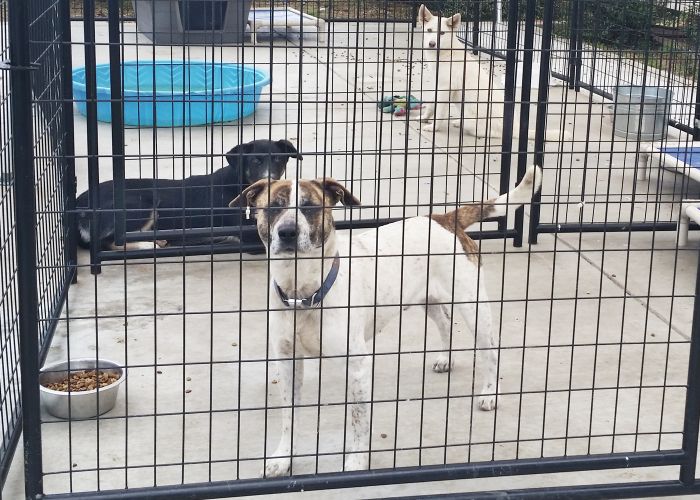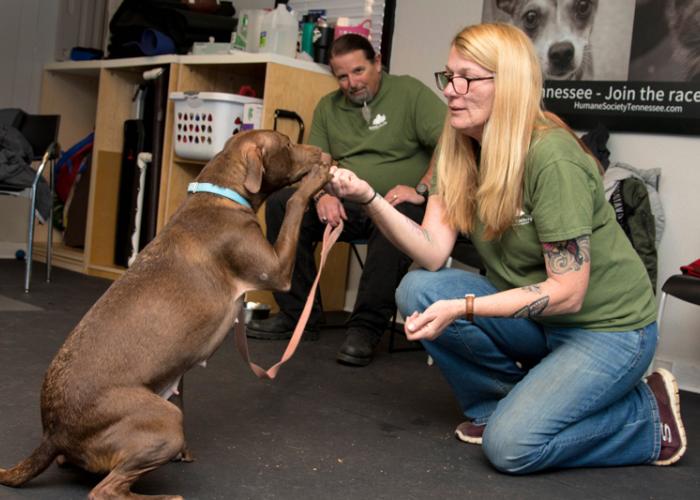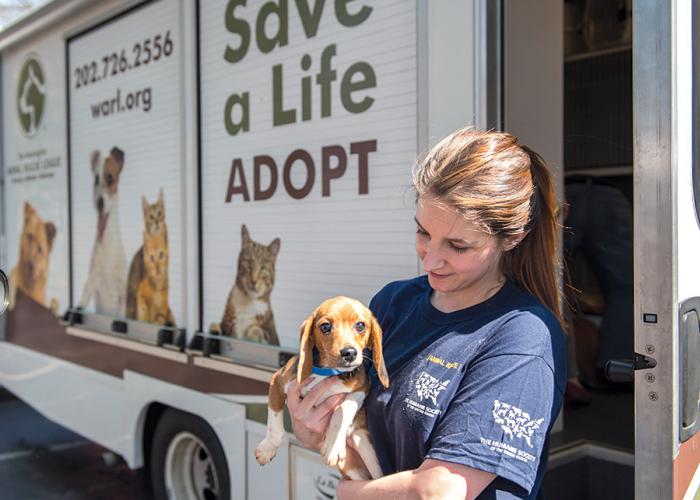The importance of isolation
Reflections on rabies and other infectious diseases

Last spring, I kept an eye on the investigation—by the state Department of Health and the Centers for Disease Control and Prevention—of a rabies case that affected a North Dakota shelter.
According to the CDC’s case report, two strays were brought to the shelter and placed together in an intake area for a five-day holding period, per standard protocol and in keeping with city ordinance.
On day 6, the dogs were placed in the general population and made available for adoption. On day 10, one dog was pulled and euthanized for behavior issues, and on day 11 the other dog was sent to a foster home. On day 16, this dog began vomiting and showing lack of balance. Two days later, the foster family brought the dog to the shelter for a veterinary exam.
Because of the clinical signs—including muscle tremors, wobbliness, and dilated pupils—the dog was euthanized, and rabies testing was performed. Three days later, laboratory diagnosis confirmed rabies virus, and the North Dakota Department of Health launched a public health investigation. All employees, volunteers, and visitors to the shelter or foster home, as well as other dogs in the shelter who could have been exposed, were considered in the investigation.
The health department ultimately recommended the shelter euthanize all exposed and unvaccinated dogs who had been in the shelter during the time of the rabid dog’s stay—an unusual and sad circumstance. This recommendation was made in accordance with the 2009 Compendium of Animal Rabies Prevention and Control, because, although the shelter minimized contact between dogs, muzzle-to-muzzle contact could not be ruled out. All 25 dogs in the shelter were euthanized. Adoption or reclaim records were used to track the 37 dogs who had since left the shelter. Twenty-five of these dogs did not have current rabies vaccination, and owners elected euthanasia for 11 of the 25 versus a mandatory six-month confinement period.
An Atypical Case—But One We Can Learn From
This unusual case captured my attention because rabies poses such an extreme risk to human health, and because this situation ultimately resulted in a shelter euthanizing its entire dog population. Whenever I consult with a shelter about any infectious disease outbreak, depopulation and threat to human health are certainly “worst-case” scenarios. Most shelters likely don’t even consider rabies virus as a population risk on a day-to-day basis.
When I read about this case, I found myself wondering … could what happened in North Dakota happen in most shelters? Is it realistic to believe this is a preventable situation in a busy animal shelter?
Rabies virus typically spreads through bites or by saliva introduced into cuts or mucous membranes. In most shelters, there is a lot of contact between animals and people. Dog-to-dog contact also frequently occurs, especially in shelters where dogs are co-housed in runs. Because animals often enter shelters incubating or shedding infectious agents, yet showing no outward clinical signs of illness, and because infectious diseases transmit through a variety of mechanisms, it seems quite possible for multiple people and animals to be exposed before a problem is identified in many facilities.
This case got me thinking beyond rabies to infectious disease control in animal shelters overall. Although most diseases in shelter animals are not as life-threatening as rabies virus, consequences for affected animals are often of life-or-death significance. While an extreme example, the serious nature and consequences of the rabies outbreak serves as a wakeup call that there are practical steps every shelter can take so that when an animal enters the front door of a shelter carrying something—whether an upper respiratory infection, gastrointestinal pathogen, or ultimately rabies virus—the problem does not “go viral.”
Quarantine vs. Isolation
Some shelters that have dealt with major infectious-disease outbreaks employ an “intake quarantine.” In this practice, a shelter groups all animals with unknown health status for a particular period of time after entry, the goal being to recognize any illness that develops before the animal goes into general population.
The actual definition of a “quarantine” is a strategy aimed at limiting exposure of the healthy population by restricting movement of animals who are considered dangerous. This is different from “isolation,” where animals who are clinically ill (symptomatic) and infected with a communicable disease are separated away from those who are healthy or exposed but not yet clinical. Animals in any quarantine situation usually appear clinically well, but may have recent exposure to an infectious disease.
Although it seems safe and logical to simply group new animals together until they can be deemed healthy, the approach is not foolproof, and can actually be detrimental. Many diseases—like canine distemper virus—incubate for weeks to months and would require lengthy quarantine periods. Not only is it impractical to hold otherwise healthy animals for long periods of time in most facilities, but animals can also experience physical and/or mental health deterioration during a quarantine.
The outbreak serves as a wakeup call that there are practical steps every shelter can take so that when an animal enters the shelter carrying something, the problem does not “go viral.”
Intake quarantines prove only variably successful, but other quarantines do have a valuable place when an infectious disease is being managed. With some infectious issues like parvo virus or canine influenza virus, animals will be most contagious before they show clinical signs. Other diseases have subclinical states during which animals can be contagious but not show clinical signs. Thus shelters may need to quarantine recently exposed—but not clinically ill—animals through a disease’s incubation period once diagnosis has occurred and sick animals are in isolation. (This is different from an intake quarantine; these animals have definitively been exposed to disease. The quarantine period allows a shelter to determine which animals will go on to demonstrate actual clinical illness. Recommended quarantine periods for common shelter diseases are based on the longest usual incubation period (time from exposure to first showing clinical signs). In the North Dakota case, per the Compendium of Rabies Prevention and Control, dogs who might have been exposed were either required to be euthanized or to undergo a mandatory six-month strict quarantine; if dogs had been current on rabies vaccine, the quarantine would have been for a lesser period (45 days).
Other Preventive Measures
If intake quarantine is not the perfect solution, what else can shelters do to help decrease exposure and minimize disease spread without stalling animal movement through the shelter?
Providing some standard of care practices to all animals as they enter a shelter reduces the risk of infectious disease as a whole. All shelter animals should receive a health evaluation at intake and regularly thereafter. Intake exams allow the shelter to promptly recognize any obvious signs of disease, attend to problems, begin documentation, and, importantly, also note pre-existing conditions so that they can be distinguished from problems that develop after animals enter the shelter.
Many shelters find that grouping animals into small cohorts helps prevent widespread problems and limits the number of animals requiring quarantine or isolation when disease does occur. Some shelters are built with a “pod” structure so that when infectious disease occurs in one group, that pod can be closed off from the rest of the population. When proper biosecurity is practiced by staff moving between animal cohorts and pods, this structure can significantly decrease spread of disease. In other shelters, animals may be separated by species, by physical and behavioral traits, and/or by age and health status. Designating an area for unvaccinated animals to be kept separately from those who have documented vaccination histories is a good practice.
Performing medical rounds is a vital practice in order to recognize changes in animals’ condition that prompt response. The Association of Shelter Veterinarians’ Guidelines for Standards of Care in Animal Shelters advises that “rounds must be conducted at least once every 24 hours by a trained individual.” (In many shelters, this duty is not necessarily performed by a veterinarian or even medical staff; a well-trained kennel staffer can do it.) By consistently evaluating food and water consumption, urination, defecation, attitude, ambulation, and checking for obvious signs of illness, staff can identify animals developing clinical signs of disease and ensure their care. As an example, the purpose of a 10-day bite confinement period is tied closely to daily rounds. Shelters that serve as rabies/bite confinement facilities have essentially agreed to perform daily medical rounds on animals that have bitten or scratched a human. (With rabies virus, veterinary observation is usually required at some point by the health department.) Rabies virus is excreted in animals’ saliva for only a few days during illness and/or before illness or death. The purpose of observation is to report any illness suggestive of rabies to the health department so that the risk to human health can be mitigated.
The Benefits of Isolation
Proper establishment and use of true isolation is critical to limiting spread of disease. The ASV Guidelines also state that “Allowing animals with severe infectious disease to remain in the general population is unacceptable. Even animals with mild clinical signs of contagious disease should not be housed in the general population as doing so creates a substantial risk of widespread disease transmission.” Also according to the Guidelines, “All facilities should have a means of providing isolation that will allow for humane care and not put other animals at risk. Isolation may be accomplished physically on-site, or through transfer to an appropriate facility.”
Although isolation typically occurs on-site in a brick-and-mortar facility, sheltering organizations are increasingly diverse in their models of service and must be prepared to provide isolation models suited to their particular situations. Foster homes, contract veterinary clinics, and other shelters can provide a place of isolation when a shelter is unable to isolate on-site. Whether working with a large, well-funded organization that has a facility, a small, home-based rescue group, a transporting agency, or a disaster response team, the plan must provide care for infectious animals that does not compromise the well-being of healthy animals in the facility.
Ideally, an isolation area will be used only for that purpose, and should be located where animals can be moved in and out without exposing healthy animals. Access should be limited to specific, necessary staff, and the area should have the following minimum characteristics:
- a sink for hand washing and treatment purposes
- air flow with exhaust separated from other animal housing areas
- appropriate lighting; ideally, windows or other natural light sources
- materials/surfaces that are easy to clean and disinfect, and items that are either disposable or easy to sanitize
- sanitation that doesn’t expose other animals in the process (e.g. proper drainage system, guillotine kennels, etc.)
- complete separation from any other animals’ living space and from quarantine areas
- cages and kennels that prevent direct contact between animals
- clear signage to indicate that infectious animals are housed within
- measures to reduce stress (noise abatement, species separation, etc.)
- separate equipment and supplies used exclusively in the isolation area
- dedicated space for storage of items needed for biosecurity, such as a treatment cart; personal protective equipment (Scrubs, Tyvek suit, gowns/aprons, rubber boots, gloves, eyewear, disposable shoe covers); hand soap/sanitizer; paper towels; garbage bags; lidded garbage can; thermometers and other specific equipment
Limiting the people who come into contact with infectious animals to only essential animal care personnel will help reduce disease spread. The fewer the individuals, the lesser the risk. In North Dakota, 21 individuals, including nine shelter staff and one volunteer, received post-exposure rabies prophylaxis. In this instance, this may have been unavoidable, but the case speaks to how easy it is for large numbers of people to come into contact with small numbers of animals, especially in high-volume facilities.
Limiting the people who come into contact with infectious animals to only essential animal care personnel will help reduce disease spread.
Isolation areas should optimally be placed or designed so that infectious animals can be transferred to isolation from the facility in such a way as to minimize exposure. An outdoor entrance away from the main lobby is ideal. Less optimally, aim for placement toward the back of the shelter, a less heavily trafficked area, or where people moving in and out of the area can be regulated.
In most shelters, staffing is limited, and people will need to move on to other duties after working in isolation. It is therefore critical that staff understand the nature of the infectious disease of concern and have clear instruction to minimize disease transmission potential. Written protocols are an important foundation to inform staff assigned to isolation areas on how to handle patients, sanitize the environment, and protect themselves and the rest of the shelter from transmission of disease.
Often, homeless animals have not had the benefit of good prior veterinary care. Providing basic preventive health care measures like vaccination and parasite treatment on arrival are key to actively improving animals’ ability to resist infectious disease. Vaccines play a role in preventing some common shelter diseases, limiting the severity and spread of others, as well as in protecting public health. In keeping with the guiding principles that have been put forth by the ASV, the American Animal Hospital Association (AAHA) and American Association of Feline Practitioners (AAFP), dogs should receive Da2PP and cats should receive FVRCP vaccinations on entry starting at 4-6 weeks of age and repeating every two to three weeks until 16-20 weeks of age. (See resources below for more details.) Adult animals should be vaccinated once with a repeat FVRCP or Da2PP two to three weeks after the initial. Dogs should also be vaccinated for Bordetella bronchiseptica.
Vaccination for rabies is also recommended for shelter animals. Although providing rabies vaccine at the time of admission does not protect against an infection acquired prior to shelter entry, and therefore will not mitigate concern for human health if that animal were to bite a person during his shelter stay, the National Association of State Public Health Veterinarians currently recommends shelter animals receive rabies vaccination prior to adoption whenever possible. Both AAHA and AAFP advise vaccination at the time of admission for animals entering shelters where a long-term stay is anticipated. (Note that veterinary practice acts in some states dictate who may administer vaccines, without exemption for animal shelters. This can be a challenge for shelters that do not employ regular staff veterinarians and/or certified technicians.)
Due to a higher risk of exposure, shelter staff and volunteers who routinely work with companion animals or wildlife are also advised to consider receiving pre-exposure vaccinations against rabies. In a follow-up report on the North Dakota rabies case, the Center for Disease Control stated, “animal shelters should ensure that adopted animals are vaccinated against rabies, consider pre-exposure prophylaxis for employees and volunteers, and prevent contact between unvaccinated animals to decrease the risk for rabies virus transmission.” Any vaccinations provided in the shelter should be properly documented (including rabies certificates) in the animal’s medical record.
In the United States, we are fortunate that rabies is an uncommon problem in animal shelters. The prospect of ever dealing with such a daunting disease outbreak is highly unlikely for most shelters. However, it is most certainly not an impossibility. As I was writing this piece, newspapers in North Carolina were reporting a story of a cat adopted from a shelter in Wake County who appeared healthy at the time of adoption, but went on to develop clinical signs and ultimately test positive for rabies. Numerous people, animals, and the adopter had been exposed.
Still, other diseases are almost certain to present more frequently. Perhaps one of the big lessons from the North Dakota rabies case is that every animal who comes to a shelter has potential to both transmit and acquire infectious disease. Some animals present with greater risk than others. This case serves as an excellent reminder to us to remain vigilant and properly practice intake, vaccination, quarantine, and isolation strategies. In the majority of cases, these vital tools can minimize overall risk to the animal population and to the people in the shelter.







